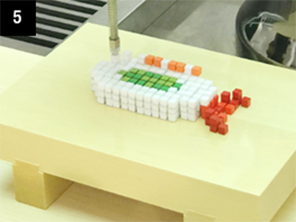Open Meals is a company that aims to digitize all of the world’s foods – and then 3D print them. They’re creating a digital, patent-pending Food Base that stores information such as flavor, color, shape, texture, and nutrients of different kinds of foods. A user would select the food they wanted from the database, and then the company’s Pixel Food Printer would 3D print small pixel cubes in the shape of that food and injected with the flavors, colors and nutrients of the food.
Why, you might ask? Why not just eat the actual food? While nature-made (or man-made) foods will certainly always have their place, the team at Open Meals want to expand the availability of foods to people all over the world. People could simply download food as easily as downloading music. Want to try Ethiopian food, but can’t find a restaurant? Just press a button.It’s an intriguing idea for those who live in so-called “food deserts” where access to a healthy variety of food is limited, or for regions of the world suffering from food scarcity. It’s also a possibility for astronauts. If 3D printed food really does carry the same nutrients as regular food, it could potentially solve a lot of problems.Which brings us back to pixelated sushi. This week at SXSW, Open Meals presented an assortment of 3D printed sushi that looks like something Mario would eat – or be chased by, I’m not sure. Open Meals calls this project Sushi Teleportation.
Eventually, the company wants to shrink the pixels so that they look a bit more realistic, although the 8-bit aesthetic of the current foods is really pretty cool. It doesn’t exactly look like real food, though – and, apparently, doesn’t taste much like it either. Mashable reports that the sushi at SXSW was not exactly, well, good, but Open Meals is working on that, too – it’s still difficult, at the moment, to code the gel pixels with the right flavors.
- The stall robot
- Testing stacking speed
- Edible pixel maguro tuna sushi [Images: Open Meals]
A lot of work remains to be done by Open Meals, but they’re dedicated, and they may be on to something. A lot of people still think of 3D printed food as a gimmick, but it’s already shown itself to be a potential answer to a lot of problems, from gluten allergies in restaurants to difficulty swallowing.
If Open Meals can open up access to a variety of foods for people who can’t otherwise easily access them, it could do a world of good in improving nutrition for people all around the world. As long as they can get it to taste good first.
Would you eat 3D printed sushi? Discuss this and other 3D printing topics at 3DPrintBoard.com or share your thoughts below. [Source: Mashable]
Subscribe to Our Email Newsletter
Stay up-to-date on all the latest news from the 3D printing industry and receive information and offers from third party vendors.
You May Also Like
Industrial Giant Ingersoll Rand Leads $19M Round Backing Inkbit’s AI-Driven 3D Printing
Inkbit, the Massachusetts-based original equipment manufacturer (OEM) of multi-material, AI-integrated 3D printers, has closed a $19 million financing round. Ingersoll Rand, a US giant in the industrial equipment sector, led...
3D Printing Unpeeled: Digital FDM Filament for Functional Gradients
Just published in Nature, a paper by a Seoul National University team looks at “3D printing with a 3D printed digital material filament for programming functional gradients.” Sang-Joon Ahn, Howon...
3D Printing Unpeeled: $5000 Cold Spray 3D Printer, Roland DGA & Living Materials
The AeroForge is a $5000 cold spray metal printer for copper made by a student team at Rice University. In a paper for ACS Central Science a team from Nanjing...
3D Printing News Briefs, April 27, 2024: Research, Digital Dentistry, Cycling, & More
We’re starting today’s 3D Printing News Briefs with some research into 3D printed luminescent quantum-dot polymer architectures and free-form laser beam shaping, and then on to an open source 4-axis...





































